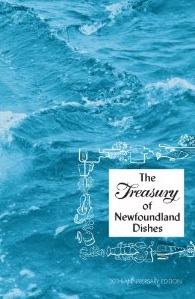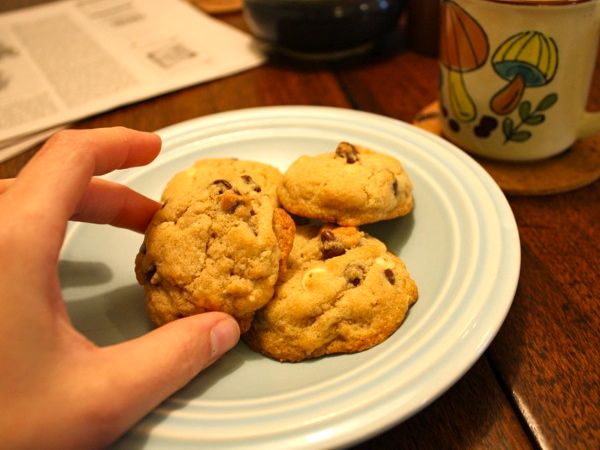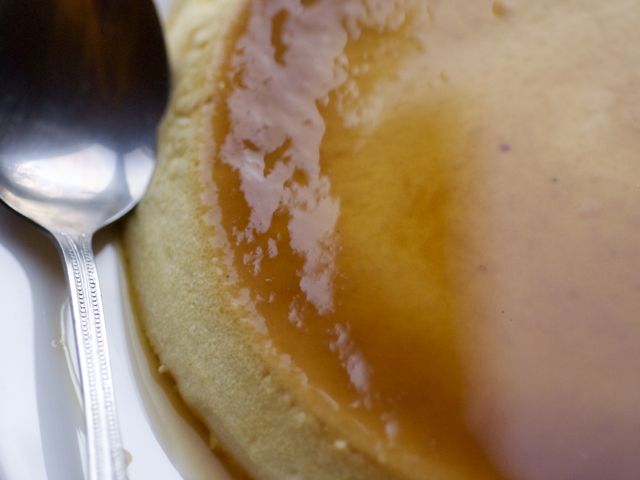
bookcover, l
(article, Sharon Hunt)
[%pageBreakSettings nobreak=true][%adInjectionSettings noInject=true] I first fell in love with community cookbooks just before I turned 13, when I was poking around in my mother’s closet looking for hidden birthday presents. I didn’t find anything wrapped up for me, but I did find two great gifts. [[block(sidebar). h1.Featured recipes]] The spiral-bound The Treasury of Newfoundland Dishes had a blue-and-white cover and the aromas of meals long past. For me, the initial gift of this book was finding my mother’s name in the list of contributors: Mrs. Oswald Hunt, of Bell Island. Soon, I also spotted my grandmothers' and three aunts’ names as well. I felt giddy. Women in my family had been published! For a girl who wanted nothing more than to be a published writer, this was the best gift I could receive. It proved that my dream could come true. [%image reference-image float=right width=400 caption="Cookies from a community cookbook."]When I asked about the book, my mother said that copies had been sold to raise money for community services on the island where she and my father were born and raised. Although she couldn’t remember which recipe she contributed, she quickly located her mother’s prized white-bread recipe. "There’s a good recipe for baked custard here, too," she noted. The Treasury of Newfoundland Dishes was published in 1958 and has just recently been re-issued. Initially, it was compiled to "preserve the distinctive cooking art of our Island." It was also used by women like my mother to raise money for social needs. Although the cookbook includes unusual items, such as preserved moose and fried cod tongues, my favorite recipes are that white bread, the rhubarb catsup (which really is “delicious with cold meat,” as the recipe notes promise), and the baked custard my mother pointed out. [%image bookcover float=left width=250 caption="Recipes from the author's female relatives appear in this classic community cookbook."] It's not the best custard I’ve ever tasted, but it's one of the comfort foods of my childhood, and I turn to it in stressful times. When I was 13, my mother made it for me on Christmas Day, when I was struck down with the mumps. Two decades later, a few days before she died, I made it for her. Community cookbooks were first produced during eras when women had little power outside the home. These books gave them an opportunity to work together toward a common (usually charitable) goal. Women’s groups from churches or synagogues, schools or clubs produced books filled with recipes that represented the food they cooked and served at their tables. Published in small runs and often cheaply bound, they are hard to find now, but whenever I go to a church bazaar or a flea market, I look for them. Not only do community cookbooks provide a snapshot of domestic life in different times, they also show what and how food was prepared. For example, lard was still widely used in recipes in Homemaker’s Delight, published in 1973 by the New Dundee (Ontario) Women’s Institute. The book — which proudly proclaims itself “For Home and Country” — includes a recipe for Spiced Sugar Doughnuts deep-fried in lard. I tried vegetable oil as a healthier alternative, but the doughnuts fried in lard tasted better. Homemaker's Delight also includes a recipe contributed by a Mrs. Harold Schmitt for Chocolate Butterscotch Chip Cookies that earned a check mark from my dad, the finest baker I’ve ever known. Mrs. Schmitt’s recipe calls for shortening, in addition to butter, and Dad refused to “play around with this woman’s success!” [%image custard float=right width=400 caption="Baked custard from 'The Treasury of Newfoundland Dishes.'"] Over the years, community cookbooks have been successful fundraisers. Some have tallied up astronomical sums and become staples in the cookbook world, such as [%amazonProductLink asin=1557094365 "The Settlement Cook Book"]. First published in 1901 by the Milwaukee Jewish Mission to benefit newly arrived Jewish immigrants, it has run through more than 40 editions and sold more than a million copies. The idea of creating cookbooks to raise money began in America during the Civil War, when A Poetical Cook-Book was produced by women to raise money for field hospitals. Their small book first sold in Philadelphia in 1864. Among the recipes was one for hasty pudding, a dish made of grains cooked in milk or water and featured in the song "Yankee Doodle." Instructions for recipes are often in paragraph form, and not always comprehensive; after all, they came from home cooks who seldom if ever consulted a recipe when they cooked. Still, the recipes usually work, because they have been passed from generation to generation, allowing lots of time for refinement. But apart from their charitable causes, community cookbooks were a labor of love, with recipes handed down from mother to daughter as gifts to be treasured. Certainly, whenever I open The Treasury of Newfoundland Dishes and see my mother’s name, I know I’m holding a gift beyond measure. p(bio). Sharon Hunt's articles have appeared in numerous publications, including Reader's Digest, The Globe and Mail, Shambhala Sun, and Edible Toronto. She is currently writing a memoir about growing up in a family of superb cooks and bakers.

bookcover, l

reference-image, l

custard, l

featurette-image, l

newsletter-image, l